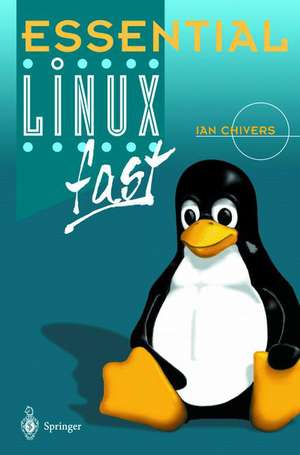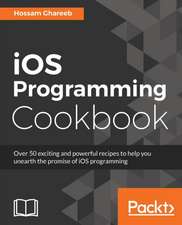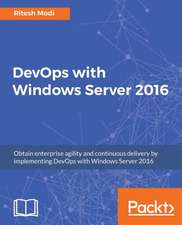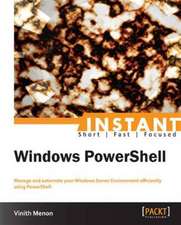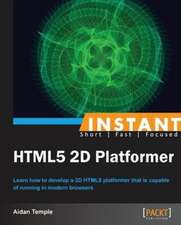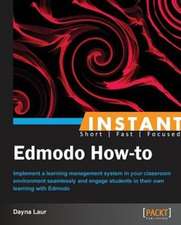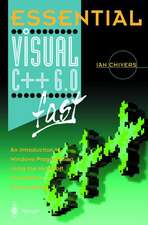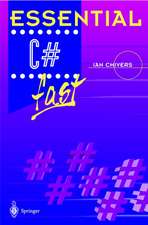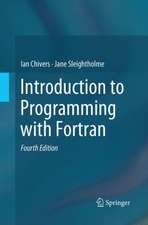Essential Linux fast: Essential Series
Autor Ian Chiversen Limba Engleză Paperback – 25 iun 2001
Essential Linux fast covers areas such as:
- The essential preliminaries that should be carried out before installing Linux
- Installing a Linux system
- Configuring peripherals
- Using X windows
- Basic and intermediate Unix commands
- Using the Internet with Linux
- Using Linux for document preparation
- Using Linux for programming
If you want to make the switch from Windows, this is the book you need. Ian Chivers tells you how to get and install Linux and explains why Linux is becoming the hottest operating system of the millennium.
Din seria Essential Series
-
 Preț: 40.82 lei
Preț: 40.82 lei - 20%
 Preț: 333.72 lei
Preț: 333.72 lei - 20%
 Preț: 334.86 lei
Preț: 334.86 lei - 20%
 Preț: 330.56 lei
Preț: 330.56 lei - 20%
 Preț: 331.40 lei
Preț: 331.40 lei - 20%
 Preț: 308.87 lei
Preț: 308.87 lei - 20%
 Preț: 329.58 lei
Preț: 329.58 lei - 20%
 Preț: 330.24 lei
Preț: 330.24 lei - 20%
 Preț: 273.32 lei
Preț: 273.32 lei - 20%
 Preț: 333.40 lei
Preț: 333.40 lei - 20%
 Preț: 198.66 lei
Preț: 198.66 lei - 20%
 Preț: 329.26 lei
Preț: 329.26 lei - 20%
 Preț: 304.94 lei
Preț: 304.94 lei - 20%
 Preț: 641.49 lei
Preț: 641.49 lei - 20%
 Preț: 327.12 lei
Preț: 327.12 lei - 20%
 Preț: 328.60 lei
Preț: 328.60 lei - 20%
 Preț: 333.54 lei
Preț: 333.54 lei - 20%
 Preț: 308.07 lei
Preț: 308.07 lei - 20%
 Preț: 239.43 lei
Preț: 239.43 lei - 20%
 Preț: 334.38 lei
Preț: 334.38 lei - 20%
 Preț: 638.69 lei
Preț: 638.69 lei - 20%
 Preț: 328.79 lei
Preț: 328.79 lei - 20%
 Preț: 334.71 lei
Preț: 334.71 lei - 20%
 Preț: 639.02 lei
Preț: 639.02 lei - 20%
 Preț: 330.56 lei
Preț: 330.56 lei - 20%
 Preț: 327.29 lei
Preț: 327.29 lei - 20%
 Preț: 641.67 lei
Preț: 641.67 lei
Preț: 332.57 lei
Preț vechi: 415.71 lei
-20% Nou
Puncte Express: 499
Preț estimativ în valută:
63.66€ • 66.88$ • 53.50£
63.66€ • 66.88$ • 53.50£
Carte tipărită la comandă
Livrare economică 11-25 martie
Preluare comenzi: 021 569.72.76
Specificații
ISBN-13: 9781852334086
ISBN-10: 1852334088
Pagini: 240
Ilustrații: VIII, 230 p. 352 illus.
Dimensiuni: 155 x 235 x 13 mm
Greutate: 0.42 kg
Ediția:Softcover reprint of the original 1st ed. 2001
Editura: SPRINGER LONDON
Colecția Springer
Seria Essential Series
Locul publicării:London, United Kingdom
ISBN-10: 1852334088
Pagini: 240
Ilustrații: VIII, 230 p. 352 illus.
Dimensiuni: 155 x 235 x 13 mm
Greutate: 0.42 kg
Ediția:Softcover reprint of the original 1st ed. 2001
Editura: SPRINGER LONDON
Colecția Springer
Seria Essential Series
Locul publicării:London, United Kingdom
Public țintă
Professional/practitionerCuprins
1. Overview.- Assumptions.- What is Linux?.- What is POSIX?.- What is Unix?.- Brief history of networking:TCP/IP and the Internet.- The rest of the book.- Acknowledgements.- 2. Linux Versions.- Red Hat.- SuSe.- Overview of the installation options.- 3. The Preliminaries.- How to find out hardware details about your system.- Hardware and associated manuals.- Your DOS and Windows distribution disks.- Making boot floppies.- What additional files are needed?.- Autoexec.bat and config.sys.- CD-Rom drivers.- Backing up your work files.- Hard disks background.- FDISK.- What type of Linux installation?.- Partitions and the Linux file system.- Printing documentation prior to the install.- Boot floppy.- TCP/IP and networking.- Final note.- 4. Installing Linux.- Single booting at home, local area network, booting from /boot.- Dual boot system at home, local area network, booting from CD.- Dual boot system at home, local area network, booting from /boot.- Partitionless install.- Single boot system at work, network connected, booting from /boot.- Dual boot system at work, network connected, LiLo.- Monitor and graphics card.- Summary.- Security and Linux.- Bibiliography.- 5. Linux and Windows.- X-Windows and XFree86.- Windows managers.- Some basics.- Double click versus single click.- Logging on for the first time.- KDE.- Gnome.- Summary.- 6. Basic Unix.- Command examples.- Getting help.- Basic DOS and Unix counterparts.- Other Unix commands.- Accessing the floppy drive.- Accessing the CD-Rom drive.- Text editors.- 7. System Administration.- The Filesystem Hierarchy Standard (FHS).- Accessing the floppy drive.- Accessing the CD-Rom drive.- Making a boot floppy.- Linuxconf.- YaST — Yet another Setup Tool.- Setting up a printer.- Setting up a modem.- Setting up a sound card.- Settingup a scanner.- Setting up a Web camera.- CD rewriter.- System start-up and shutdown.- Making more memory available.- Accessing a Windows partition.- Miscellaneous.- 8. Networking and Security.- Networking basics.- Basic network terminology.- Networking at home.- Network administration via graphical interfaces.- Networking at work.- Network set-up programs.- Networking utilities.- Security.- Sendmail.- Other security options.- System logs.- Summary.- 9. More Unix.- Computer system overview.- The command interpreter or shell.- Pattern matching.- Metacharacters.- Unix metacharacters and associated programs.- Working with files, directories and the file system.- Help.- vi.- Managing jobs and processes.- Managing your environment.- Summary.- 10. Installing Software.- RPM.- What is installed?.- Gnome RPM — GnoRPM.- YaST.- Compression.- Mounting the CD-Rom drive.- Adobe Acrobat.- SuSe 6.4 Linux and ed.- GNU Fortran 77.- NAG Intel g77 Double Precision Numeric Library.- Java.- Summary.- 11. Text Formatting and Document Production.- Electronic publishing basics.- Text tools.- TeX.- La Tex.- Fonts.- W3C.- Graphics formats.- Bitmap.- HTML.- Portable Document Format (PDF).- PostScript.- Ghostscript.- XML.- Summary.- 12. Programming Languages.- History.- C.- C++.- Intel/Linux Fortran compilers.- Java.- Practical extraction and report language (Perl).- 13. Miscellaneous.- Electronic mail — email.- Linux as a platform for a Web server.- Database management.- High-performance computing.- 14. Resume.
Caracteristici
Gets the reader up and running using Linux fast
